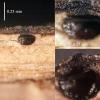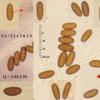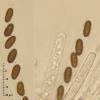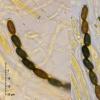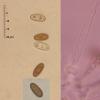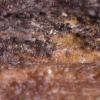
09-12-2025 12:06
 Andgelo Mombert
Andgelo Mombert
Bonjour,Je recherche l'article concernant Hypobryo

07-12-2025 16:07
Arnold BüschlenHallo, ich habe in einer Moos-Aufsammlung (epiphy

08-12-2025 21:04
Mark Stevens"Hello everyone,I'm relatively new to microscopy (

08-12-2025 18:59
 Lothar Krieglsteiner
Lothar Krieglsteiner
.. found by a seminar-participant, I do not know t

08-12-2025 17:37
 Lothar Krieglsteiner
Lothar Krieglsteiner
20.6.25, on branch of Abies infected and thickened

16-03-2014 22:00
Hello,I found this species a few months ago but ha

08-12-2025 13:39
Thomas Læssøehttps://svampe.databasen.org/observations/10572899
Anthostomella (?) on Berberis
Enrique Rubio,
04-07-2013 14:02
Under a melanized, epidermial blackish tissue with inconspicuous perithecial mounds, we have collected these inmersed, isolated. not really stromatic perithecia up to 0.2 mm in diameter under a clypeate structure.
The long cylindrical 8-spored asci have an appical apparatus IKI bb and the brownish (at maturity) ascospores have a germ-slit full spore lenght and they have not visible appendages.
The fungus was on still attached branches of Berberis vulgaris at 1700 m of altitude.
With the classic keys I arrive to the genus Anthostomella. What do you think?
Thanks again
Jacques Fournier,
04-07-2013 14:26

Re : Anthostomella (?) on Berberis
Hola Enrique,
possibly Anthostomella but not a common species at first view. I checked Lu & Hyde's monograph to no avail. Could you be more specific about the clypei, are they separate or do they form a superficial pseudostroma by coalescing? Are the asci short or long pedicellate? Do ascospores have a mucilaginous sheath? something to test in India ink, just add a small drop to the edge of a water mount, it's better than to observe directly in India ink, otherwise dilute it.
Buena suerte!
Jacques
possibly Anthostomella but not a common species at first view. I checked Lu & Hyde's monograph to no avail. Could you be more specific about the clypei, are they separate or do they form a superficial pseudostroma by coalescing? Are the asci short or long pedicellate? Do ascospores have a mucilaginous sheath? something to test in India ink, just add a small drop to the edge of a water mount, it's better than to observe directly in India ink, otherwise dilute it.
Buena suerte!
Jacques
Enrique Rubio,
04-07-2013 17:49
Re : Anthostomella (?) on Berberis
Hi Jacques
There are a superficial, thin and continuous blackish pseudostroma over the isolated perithecia, but at this level it seems to be thicker.
I have seen any mucilaginous sheath or appendages in china ink or nigrosine. The asci are shortly stipitate (i.e 55 microns long for the pars sporifera vs 35 for the stipes)
There are a superficial, thin and continuous blackish pseudostroma over the isolated perithecia, but at this level it seems to be thicker.
I have seen any mucilaginous sheath or appendages in china ink or nigrosine. The asci are shortly stipitate (i.e 55 microns long for the pars sporifera vs 35 for the stipes)
Jacques Fournier,
04-07-2013 18:20

Re : Anthostomella (?) on Berberis
thanks for the information, after checking the key in the monograph I failed to find a match. Anyway the continuous pseudostroma is not typical of Anthostomella. It rather recalls the fungi placed in Lopadostoma subgenus Anthostomopsis Rappaz (1995), as do the ellipsoid-equilateral ascospores. There are only three species in that subgenus, one L. flavoviride has ascospores that might fit but the peudostroma is said to be green black. Is that the case?
Tell me if you don't have Rappaz paper.
Cheers,
Jacques
Tell me if you don't have Rappaz paper.
Cheers,
Jacques
Enrique Rubio,
04-07-2013 18:51
Enrique Rubio,
04-07-2013 18:54
Re : Anthostomella (?) on Berberis
Can you see them in the image?
Jacques Fournier,
04-07-2013 19:06

Re : Anthostomella (?) on Berberis
hum, not striking! I would not advise you to use this name, maybe someone will have a better idea.
Cheers,
Jacques
Cheers,
Jacques
Enrique Rubio,
04-07-2013 19:22
Re : Anthostomella (?) on Berberis
Of course! They are not so conspicuous!
Thanks, Jacques
Thanks, Jacques

